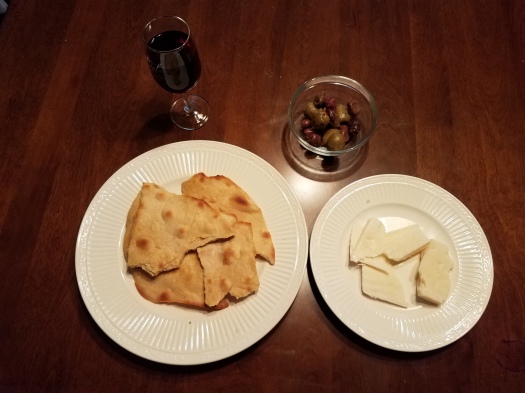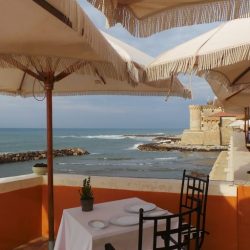
There is an ancient Sardinian peasant proverb ‘Chie hat pane, mai no morit‘ which means ‘with bread you will never die.’ Not surprising that various breads are a staple of the Sardinian diet.
The most popular is an unleavened (yeast-free) flatbread called Pane Guttiau or “Carta di Musica” (“Music card”) for its paper thin appearance. It is most often eaten with Pecorino cheese and Sardinian wine.
Pane Guttiau is very similar to another Sardinian flatbread Pane Carasau which contains yeast. Remains of the bread were found in archaeological excavations of Nuraghes (ancient Sardinian stone buildings) so this bread was consumed on the Sardinian island prior to 1000 BC.
Below is the recipe and I want to emphasize that it calls for Whole Wheat Pastry flour which is not the same thing as Whole Wheat flour. I was able to find this flour “Bob’s Red Mill Whole Wheat Pastry flour” in the healthy food section of my grocery store.

The ingredients needed are:
- Whole Wheat Pastry flour – 3 cups (2 cups for the bread, 1 cup for the kneading process)
- Semolina flour – 2 cups
- Extra Virgin Olive Oil – 5 oz (150cc)
- Rosemary sprigs – 2-3
- Water (lukewarm) – 2 cups
- Sicilian Sea Salt (to taste)
- Preparation time – 45 minutes , Cooking time – 10 minutes
Directions:
- To make the dough, combine 2 cups of whole wheat pastry flour, 2 cups of the semolina flour and salt in a large bowl. Add some lukewarm water and mix until it is moist.
- Knead the dough until it is not sticky. Sprinkle a little amount of the remaining flour on a plain surface and knead the dough on it. Knead it for 12-15 minutes until it is smooth.
- Wrap the dough with plastic all over and let it stand for 1 hour sand 20 mins at room temperature.
- Put the olive oil and rosemary in a pan and heat gently. Do not boil. Keep warm over a low heat for about 10 minutes to allow the flavor of the herbs to infuse the oil. Leave to cool completely.
- For baking, preheat the oven to 450°F. Take 2 large baking sheets and dust them with the whole wheat flour. Then divide the dough into 6-7 equal pieces. Take one piece and pat on it until a disk/fairly round shape.
- Roll out the dough into a 13 inch larger disk, while turning it over and lifting it to make it even. I recommend trying to make these disks as thin as possible. Remember that this bread is called “Carta di Musica” because you are supposed to be able to read a sheet of music through it prior to baking.
- Transfer the pieces onto the baking sheet and place in oven. Bake for 3 minutes until the bread is moldable and the edges rise up. Then turn the bread and bake until it is golden in few spots and bubbles rise up. Take the bread out and plate it.
- Using a brush, garnish the bread with the rosemary-infused olive oil. Sprinkle a little Sicilian sea salt over it.
Serve with Pecorino Romano cheese, olives and Sardinian Cannonau wine.
I recommend saving the oil and applying this shortly before eating if you plan to save some of the bread and eat it later. This will retain the dexterity of the bread and prevent it from getting soggy. Store any unused bread in a Tupperware container.
Sardinian Wine
If you are looking for a great wine pairing for this bread, I highly recommend Sella & Mosca’s Cannonau di Sardegna. This is my absolute favorite red wine and I have a tried a lot of great Italian and French wines. I have tried other similar wines made from the same grape—Spanish Garnacha, French Grenache and even some other Sardinian Cannonau wines—and nothing compares with Sella and Mosca’s Cannonau.
It is a delicately spicy, herbal and fruit flavored dry red wine that is smooth and not too tanniny. It has a slight tobacco note that seems to reel in and bring balance to all the different herbs and fruit notes. This wine would pair extremely well with any tomato-based pasta dish, steak, a Cuban cigar or dark chocolate. It’s high in resveratrol, flavonoids and antioxidants that help prevent cancer and it is heart-healthy consumed in moderation as alcohol helps reduce heart attack and stroke risks.
On average, Sardinians drink two to three 3 oz glasses of wine per day and this is thought to be a contributing reason for their longevity. For my birthday, my girlfriend arranged for the local Hy-Vee to stock this wine. I thought I was going to have a nice convenient supply until it became Hy-Vee’s Registered Dietitian’s top wine pick (see below). Porca vacca! The secret is out.

So this wine is Pharmacist and Registered Dietitian approved. James Melendez aka “James the Wine Guy” gives an excellent review of this wine in the Youtube video below. He gives it a 9.2 out of 10. I’d give it a 9.4 out of 10 because you are going to have to shell out a lot more money to find a better wine.
Buon Appetito and Salute!
–Michael







